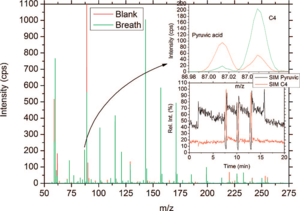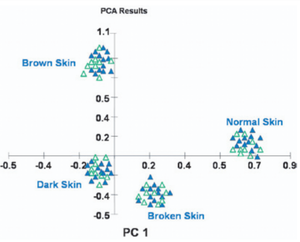Optimisation of secondary electrospray ionisation (SESI) for the trace determination of gas-phase volatile organic compounds
Leonard A. Dillon, Victoria N. Stone, Laura A. Croasdell, Peter R. Fielden, Nicholas J. Goddard and C. L. Paul Thomas
An electrospray ionisation triple quadrupole mass spectrometer (Varian 1200 L) was modified to accept nitrogen samples containing low concentrations of volatile organic compounds. Six candidate probe compounds, methyl decanoate, octan-3-one, 2-ethylhexanoic acid, 1,4-diaminobutane, dimethyl methylphosphonate, and 2,3-butanediol, at concentrations below 50 ppb(v) were generated with permeation tubes in a test atmosphere generator.
Sampling analytes from cheese products for fast detection using neutral desorption extractive electrospray ionization mass spectrometry
Zhongchen Wu, Konstantin Chingin, Huanwen Chen, Liang Zhu, Bin Jia, R. Zenobi
The development of analytical techniques suitable for sensitive, high-throughput, and nondestructive food analysis has been of increasing interest in recent years. In this study, mass-spectral fingerprints of various cheese products were rapidly recorded in the mass range of m/z 50-300 Da without any sample pretreatment, using ND-EESI-MS in negative ion mode.
Detection of Volatile Organic Compounds in Breath Using Thermal Desorption Electrospray Ionization-Ion Mobility-Mass Spectrometry
J. C. Reynolds,* G. J. Blackburn, C. Guallar-Hoyas, V. H. Moll, V. Bocos-Bintintan, G. Kaur-Atwal, M. D. Howdle, E. L. Harry, L. J. Brown, C. S. Creaser, and C. L. P. Thomas
A thermal desorption unit has been interfaced to an electrospray ionization-ion mobility-time-of-flight mass spectrometer. The interface was evaluated using a mixture of six model volatile organic compounds which showed detection limits of <1 ng sample loaded onto a thermal desorption tube packed with Tenax, equivalent to sampled concentrations of 4 μg L−1. Thermal desorption profiles were observed for all of the compounds, and ion mobility-mass spectrometry separations were used to resolve the probe compound responses from each other…
Mass spectrometric study of cutaneous volatiles by secondary electrospray Ionization
P. M-L Sinues
We investigated the volatile organic compounds emanated from the hand of two individuals, on-line by secondary electrospray ionization-mass spectrometry in positive ionization mode. The background ambient air is continuously sampled, ionized and readily mass analyzed. When the probe samples above the headspace of the hand of two subjects, several peaks …
On-line Detection of Human Skin Vapors
P. M-L Sinues, J. F. de la Mora
Vapors released by the skin in the hand of one human subject are detected in real time by sampling them directly from the ambient gas surrounding the hand, ionizing them by secondary electrospray ionization (SESI, via contact with the charged cloud from an electrospray source), and analyzing them in a mass spectrometer with an atmospheric pressure source (API-MS).
Secondary Electrospray Ionization (SESI) of Ambient Vapors for Explosive Detection at Concentrations Below Parts Per Trillion
P. M-L Sinues, J. Rus, G. F. de la Mora, M. Hernández, and J. F. de la Mora
We determine the sensitivity of several commercial atmospheric pressure ionization mass spectrometers towards ambient vapors, ionized by contact with an electrospray of acidified or ammoniated solvent, a technique often referred to as secondary electrospray ionization (SESI).
Neutral desorption sampling of biological surfaces for rapid chemical characterization by extractive electrospray ionization mass spectrometry
H. Chen, R. Zenobi
Extractive electrospray ionization mass spectrometry (EESI-MS) allows the real-time, direct analysis of complex gaseous and liquid samples without any sample pretreatment under ambient conditions. By using a neutral desorption (ND) sampling gas beam to gently impact a surface, the analyte present on a surface can be efficiently sampled and then transported …
Direct Analysis of Fatty Acid Vapors in Breath by Electrospray Ionization and Atmospheric Pressure Ionization-Mass Spectrometry
P. M-L Sinues, J. F. de la Mora
Real time analysis of human breath is achieved in an atmospheric pressure ionization mass spectrometer (API-MS) by negatively charging exhaled vapors via contact with an electrospray cloud. The spectrum observed is dominated by a wide range of deprotonated fatty acids, including saturated chains up to C14. Above C14, the background from cutaneous sources becomes dominant.
Real-time, on-line monitoring of organic chemical reactions using extractive electrospray ionization tandem mass spectrometry
L. Zhu, G. Gamez, H. W. Chen, H. X. Huang, K. Chingin and Renato Zenobi
Extractive electrospray ionization mass spectrometry (EESI-MS) for real-time monitoring of organic chemical reactions was demonstrated for a well-established pharmaceutical process reaction and a widely used acetylation reaction in the presence of a nucleophilic catalyst, 4-dimethylaminopyridine (4-DMAP) …
Rapid classification of perfumes by extractive electrospray ionization mass spectrometry (EESI-MS)
L. Zhu, G. Gamez, H. W. Chen, H. X. Huang, K. Chingin and Renato Zenobi
Extractive electrospray ionization mass spectrometry (EESI-MS) for real-time monitoring of organic chemical reactions was demonstrated for a well-established pharmaceutical process reaction and a widely used acetylation reaction in the presence of a nucleophilic catalyst, 4-dimethylaminopyridine (4-DMAP) …
Direct Analysis of Living Objects by Extractive Electrospray Ionization Mass Spectrometry
H. Chen and R. Zenobi
Spinach contaminated with E. coli leaves 200 people sick in the USA – rapid screening needed for suspected food! Epidemic − thousands of patients need to be rapidly screened in emergencies… What do these and similar headlines have in common? They all challenge modern analytical science in terms of sensitivity, specificity, speed, and especially throughput. It appears that …
Neutral Desorption Sampling of Living Objects for Rapid Analysis by Extractive Electrospray Ionization Mass Spectrometry
H. Chen, S. Yang, A. Wortmann, and R. Zenobi
Mass spectrometry is increasingly used for research purposes and routine measurements in biology, life science, the pharmaceutical industry, and in clinic diagnosis to characterize complex samples. Usually, biological samples are mixtures supported by a biological structure such as skin, tissue, muscle, or vessels and are commonly accompanied by microorganisms …
Neutral desorption sampling coupled to extractive electrospray ionization mass spectrometry for rapid differentiation of biosamples by metabolomic fingerprinting
H. Chen, A. Wortmann, Renato Zenobi
It is of increasing interest and practical importance to develop convenient methods based on mass spectrometry for high-throughput analyses of biological samples. This is usually difficult because of the complex matrix and ion suppression effects. Generation of ions at ambient conditions is a promising solution to these problems …
Differentiation of Maturity and Quality of Fruit Using Noninvasive Extractive Electrospray Ionization Quadrupole Time-of-Flight Mass Spectrometry
H. Chen, Y. Sun, A. Wortmann, H. Gu, R. Zenobi
Maturity is an essential factor that determines storage life and final quality of most fruits and vegetables. Maturity monitoring is thus of paramount importance for postharvest handling and fruit quality regulation. Ideal analytical procedures for maturity investigation require high sensitivity, specificity, and high throughput and should be noninvasive.
Electrospray ionization of volatiles in breath
P. M-L Sinues, J. F. de la Mora
Recent work by Zenobi and colleagues reports that human breath charged by contact with an electrospray (ES) cloud yields many mass peaks of species such as urea, glucose, and other ions, some with molecular weights above 1000Da.
Manipulation of charge states of biopolymer ions by atmospheric pressure ion/molecule reactions implemented in an extractive electrospray ionization source
H. Chen, D. Touboul,M. C. Jecklin, J. Zheng, M. Luoa, Renato Zenobid
A home-made extractive electrospray ionization source is coupled to a linear quadrupole ion trap mass spectrometer to investigate ion/molecule reactions of biopolymers at ambient pressure. Multiply charged biopolymers such as peptides and proteins generated in an electrospray are easily reduced to a low charge state by …
Rapid In Vivo Fingerprinting of Nonvolatile Compounds in Breath by Extractive Electrospray Ionization Quadrupole Time-of-Flight Mass Spectrometry
H. Chen, A. Wortmann, W. Zhang, and R. Zenobi
Quantitative analysis of trace constituents in exhaled gas can provide useful insights into biochemical processes in the body, thus revealing information about metabolic dynamics and providing, theoretically, a scientific base for biomarker research or clinical diagnoses. Breath, however, is rarely used practically for diagnostic purposes in clinical medicine …
Secondary Electrospray Ionization-Ion Mobility Spectrometry for Explosive Vapor Detection
M. Tam and H. H. Hill, Jr.
The unique capability of secondary electrospray ionization (SESI) as a nonradioactive ionization source to detect analytes in both liquid and gaseous samples was evaluated using aqueous solutions of three common military explosives: cyclo-1,3,5-trimethylene-2,4,6-trinitramine (RDX), nitroglycerin (NG) and pentaerythritol tetranitrate (PETN).
Secondary Ionization of Chemical Warfare Agent Simulants: Atmospheric Pressure Ion Mobility Time-of-Flight Mass Spectrometry
W. E. Steiner, B. H. Clowers, P. E. Haigh, and H. H. Hill
For the first time, the use of a traditional ionization source for ion mobility spectrometry (radioactive nickel (63Ni) beta emission ionization) and three alternative ionization sources (electrospray ionization (ESI), secondary electrospray ionization (SESI), and electrical discharge (corona) ionization (CI)) were employed with …
Secondary Electrospray Ionization Ion Mobility Spectrometry/Mass Spectrometry of Illicit Drugs
C. Wu, W. F. Siems, and H. H. Hill, Jr.
A secondary electrospray ionization (SESI) method was developed as a nonradioactive ionization source for ion mobility spectrometry (IMS). This SESI method relied on the gas-phase interaction between charged particles created by electrospray ionization (ESI) and neutral gaseous sample molecules. Mass spectrometry (MS) was used as …





















